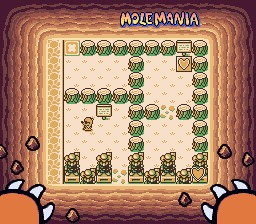 Have
you seen the Game Boy software market recently? Aside from the completely brill
Pokemon series (and Iím not being sarcastic here) thereís almost nothing to
warm the cockles of any serious gamerís heart. Part of the blame can be
attributed to the odd position the Game Boy Color is in Ė although cheap and
commanding a huge audience, the console is considered too underpowered to create
anything serious on by most software houses. So instead itís been subjected
these past few years to a wave of bad licensed games and PlayStation ports that,
in a just world, simply wouldnít be allowed to exist. Cruel, man.
Have
you seen the Game Boy software market recently? Aside from the completely brill
Pokemon series (and Iím not being sarcastic here) thereís almost nothing to
warm the cockles of any serious gamerís heart. Part of the blame can be
attributed to the odd position the Game Boy Color is in Ė although cheap and
commanding a huge audience, the console is considered too underpowered to create
anything serious on by most software houses. So instead itís been subjected
these past few years to a wave of bad licensed games and PlayStation ports that,
in a just world, simply wouldnít be allowed to exist. Cruel, man.
Fact is, the only company that treats the humble GBC seriously these days is Nintendo themselves. How many good Game Boy titles can you name that arenít by them? From Tetris and Super Mario Land back in 1989 to Donkey Kong and the Warioland series more recently, the standard of quality has not dropped one tiny bit at NOA headquarters over the years. Which is part of the reason why Mole Mania really deserves some more attention from handheld fans.
Mole Mania takes place in Jinbe Land, one of those strange video-game worlds thatíre filled with obstacles and traps set just so, making it possible for some plucky hero to make his way through them. That hero is Muddy, your typical cartoon mole whose entire family has been kidnapped by malevolent farmer Jinbe as retribution for stealing one too many head of cabbage. To get them back, eight stages, each with 20 or so single-screen overhead rooms, must be wended through.
The game itself is not unlike the Adventures of Lolo series over on the NES. Each screen has paths, obstacles and enemies that Muddy has to find a way through to open up the door to the next screen. The game starts you out in teddy-bear mode, with signposts explaining everything and new features introduced one at a time, but soon works its way up to astoundingly challenging levels after awhile. At the end of each stage is a boss that you have to defeat via some cunning platform-game-style plan.
What makes Mole Mania markedly different from Lolo is the double-sidedness of each screen. Being a mole, you can dig, and remarkably enough, many screens require you to dive in and explore underground to find out what makes them tick. Some spikes blocking your way? No problem Ė just dig under them! All this digging leaves holes, however, and these can be a pain when youíre (for example) trying to roll a giant metal ball down a path to break open the door to the next screen.
The shallow learning curve, coupled with the handholding you get through the first stage or so, make Mole Mania a much easier game to get into than most puzzle games of its ilk. You can continue after dying as much as you like, and the battery backup saves your exact place and takes you right back where you were upon power on. Puzzlers like this died as a genre during the 16-bit age because they simply got far too frustrating for the player near the end, and itís obvious Nintendo tried their best to alleviate this here. The result is really a blast.
Besides being merely a good game, however, the audiovisuals also represent the pinnacle of mono portable gaming. Muddy the 8x8 sprite is cute as all willikins and has tons of amusing animations. The music, which sounds vaguely jazzy, is about as funky as the Game Boy can get (and the Game Boy is not known for being funky). There is some Super Game Boy support (just some extra color on the title screen, unfortunately), but even in normal mono mode there is nothing about Mole Mania that seems unpolished.
Mole Maniaís worst sin was that it was released in 1996, when the Game Boy was really beginning to feel its age and a color version was still two years away. Itís really too bad Ė like most of Nintendoís releases, this game (unlike most GB titles) truly feels like its creators enjoyed what they were doing as they made it. If you have an ounce of brainpower in your body, youíll enjoy this.
